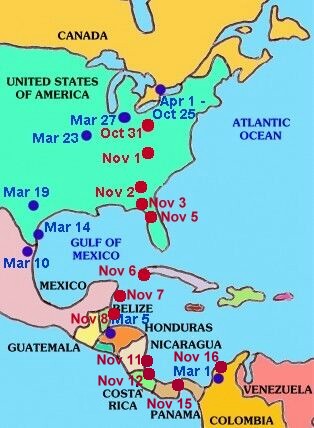The Canadian Peregrine
Foundation
Peregrine Biology:
Habitat and Distribution
Range:
While Peregrines are rare, they are remarkably widespread. In fact, the Peregrine has a more extensive natural global range than most other birds. Peregrines can be found on every continent except Antarctica.
In North America, the historical breeding range of the Peregrine (taking all three subspecies together) covered the entire continent except for the Great Plains and the southeast corner of the United States. Presently, the breeding range is restricted to most of Canada, Alaska, the western states, and scattered sites in the eastern United States.
For the most part, the three subspecies occur in different areas. The Peale's subspecies is largely restricted to coastal areas from Alaska south to Oregon. Peregrines nesting in the boreal forest and tundra of Alaska and the Canadian Arctic are mostly of the Tundra subspecies. The Peregrines over the rest of North America were historically largely Anatum birds, but as a result of the captive breeding efforts of the past 20 years, many of them are now hybrids (mostly Anatum x Tundra, but also some Anatum x Peale's and other combinations).
Migration:
The Peale's Peregrine is primarily sedentary, but both the Tundra and Anatum Peregrines generally migrate south for the winter (though the Tundra is the much more migratory subspecies, and many Anatum individuals remain on their territories throughout the year). Unlike many raptors which avoid crossing large bodies of water, Peregrines have often been seen far
out at sea, catching and eating seabirds while on the wing, and even resting at times on ships. In fact, many observations of migrating Peregrines come from sites along the Atlantic and Pacific coasts. Like many other birds, Peregrines also often migrate along mountain ranges in both the east and the west.
Studies on a few individuals from Canada and Greenland have suggested that Peregrines spend roughly one month flying south, and another month coming back north in the spring. On average, they leave their breeding grounds in September and return in March. Northern nesting birds typically leave earlier and come back later, while birds which breed further south may linger on their breeding territories longer and return sooner. Many of the urban Peregrines in eastern North America have now chosen to not migrate at all anymore - they just stay in their breeding territory all year long. This is presumably because unlike in traditional natural nesting areas, the food supply in cities (primarily pigeons and starlings) is reliable throughout the year, and thus there is no need for the Peregrines to migrate.
|
Nate's 2001 travels:
 |
|
Check out Project
Track-'em for the CPF's ground-breaking work on Peregrine migration |
Wintering Grounds:
North American Peregrines appear to winter in Central America and the northern part of South America, in countries such as Mexico, Colombia, and Ecuador. Some studies have suggested that Tundra Peregrines winter further south (as far as Argentina) than Anatum Peregrines. Further research is needed to clarify their migratory routes and their wintering grounds, as well as the hazards associated with migrating to these areas.
Breeding Habitat:
Natural: Peregrines are native to a wide variety of open habitats, including wetlands, alpine meadows, and tundra. In all cases, Peregrines choose a site which has an isolated protected spot for nesting near good hunting grounds. Most of the time this is a cliff or rocky outcrop. They prefer ledges 15 to 60 metres above ground,
with a southerly exposure, some vegetation on the ledge, and a protective overhang above. Although rare, Peregrines in some areas have been known to nest in abandoned tree nests or cavities, while others (especially in Scandinavia) nest on the ground in bogs where they are as safe from predators as they would be on a cliff. Most nests, regardless of where they are located, consist simply of a shallow depression scraped out by the adults; no nest materials are added.
The size of a breeding territory varies greatly among individual Peregrines. In some cases nests may be within less than one kilometre of each other, while in other places a pair will defend a territory with a radius of 20 kilometres or more. While several factors may be involved, it appears that food availability is the primary limitation on nesting density.
Urban: In recent decades, Peregrines have started to live in cities on an increasingly regular basis, using skyscrapers and high bridges as nesting sites. In fact, the majority of Peregrines that have settled in eastern North America in recent years have chosen urban centres. Among the cities which have had nesting Peregrines in recent years are Toronto, Mississauga, Hamilton, London, Ottawa, Detroit, Cleveland, Columbus OH, Buffalo,
Rochester, New York, Boston, and Pittsburgh.
For up-to-date daily observations of current nest sites, see our Sightings menu. |
To a Peregrine, a sheltered ledge high on an office tower is much like a towering cliff. Some Peregrines scrape out a small nest in loose gravel or debris on their chosen ledge, but in many places human observers are now
providing gravel-filled nesting boxes for them. The boxes provide added security for the Peregrines by preventing the eggs from rolling off the ledge. In some situations the box also shields them somewhat from the elements, and from the eyes of predators. Peregrines usually are quick to accept the nest box when it is offered.
Return
to Peregrine Biology home page
©
Canadian Peregrine Foundation
